The allure of rustic home decorating is deeply rooted in its homage to a simpler time, capturing the raw beauty of the American West. This style, with its earthy tones and rugged textures, evokes feelings of warmth, simplicity, and an undeniable connection to nature. It’s about creating a space that feels both lived-in and loved, a sanctuary from the hustle and bustle of modern life. In this comprehensive guide, we’ll journey through the essential elements that define this aesthetic, offering detailed tips and insights to help you transform your abode into a cozy Western retreat, brimming with character and charm.
Contents
1. Embrace Natural Materials
At the heart of the rustic theme is an unwavering commitment to natural materials. These materials, with their inherent textures and colors, form the foundation of the rustic aesthetic. Envision sturdy wooden beams spanning ceilings, their grain-telling tales of decades gone by. Imagine stone fireplaces, their rugged surfaces offering both warmth and a visual anchor to living spaces. And then there’s leather, with its supple surface and rich hue, adding a touch of luxury and ruggedness simultaneously. Reclaimed wood, especially, with its weathered appearance and history, can be repurposed for flooring, wall panels, or bespoke furniture pieces.
2. Color Palette
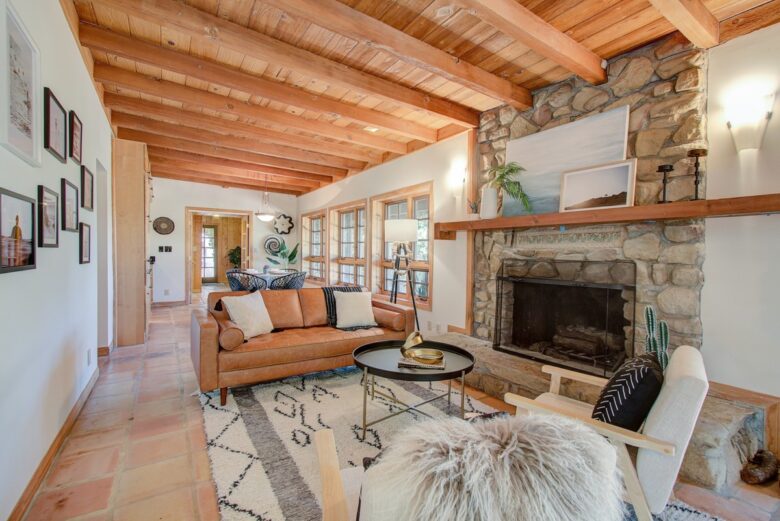
Source: redfin.com
The Western rustic aesthetic draws its color inspiration directly from the landscapes of the great American outdoors. The palette is a symphony of earthy tones, reminiscent of sprawling deserts, dense forests, and majestic mountains. Dominant hues include browns, tans, and greens, each shade echoing the natural elements found in the West. These colors, when used thoughtfully, can make spaces feel warm, inviting, and harmonious. Complement these with richer, deeper hues like burgundy or navy for accents, perhaps in the form of throw pillows or rugs.
3. Furniture Selection
When it comes to furniture, the Western rustic style prioritizes pieces that combine functionality with aesthetics. The emphasis is on sturdy, well-crafted items that tell a story. Wooden tables, weathered from years of use, become the centerpiece of dining rooms, bearing witness to countless family gatherings, and when paired with full grain leather chairs make an ideal combination. Leather sofas, aged to perfection, offer comfort while adding a touch of rugged elegance.
When selecting furniture, consider pieces with visible grains, knots, and imperfections – these details add authenticity and character. Additionally, handcrafted or artisanal pieces can elevate the overall ambiance, infusing spaces with a sense of history and craftsmanship. Remember, in a Western rustic home, each furniture piece doesn’t just fill space; it adds to the narrative.
4. Textures and Fabrics
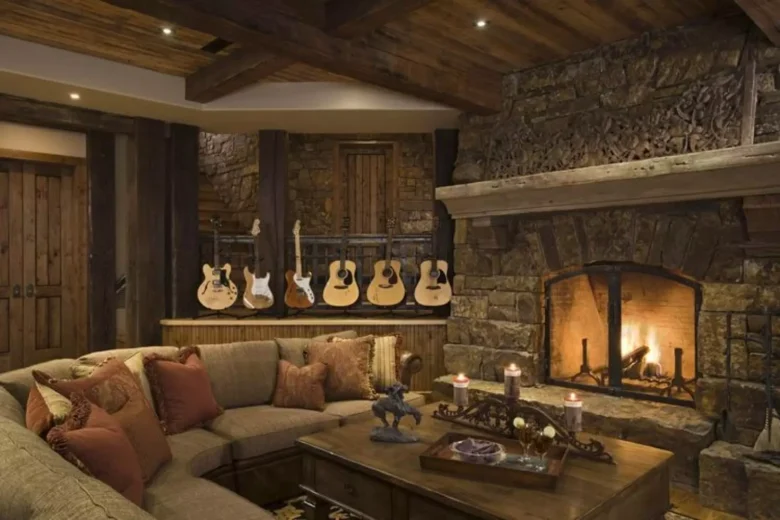
Source: foyr.com
Texture plays a pivotal role in bringing the rustic theme to life. Distressed wood, with its roughened surface, introduces a tactile dimension, inviting touch and exploration. Fabrics, too, play a crucial role. Think of soft woolen throws draped over sofas, or cowhide rugs underfoot, their unique patterns adding both comfort and visual intrigue. Linen cushions, burlap curtains, or even denim accents can further enhance the rustic feel.
5. Rustic Decor Accessories
No Western rustic home is complete without thoughtfully chosen decor accessories. These items, often steeped in history and tradition, add layers of depth and personality. Consider decorating with vintage cowboy hats, their worn edges telling tales of adventures past. Horseshoes, once considered symbols of luck, can be repurposed as door knockers or wall hangings. Vintage signage, especially those with faded paint and rustic metal, can evoke nostalgia while adding a touch of whimsy. Old lanterns, wooden crates, or even antique spurs can be strategically placed to accentuate the Western theme, making spaces feel both curated and authentic.
6. Cozy Lighting
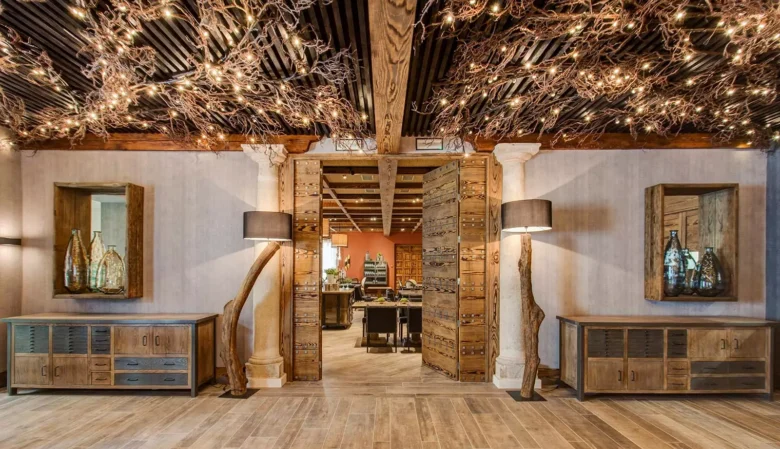
Source: foyr.com
Lighting, often overlooked, plays a transformative role in creating a cozy Western retreat. The right fixtures can cast warm, inviting glows, making spaces feel intimate and welcoming. Rustic fixtures, like antler chandeliers or wrought iron sconces, can serve as statement pieces. Lantern-style lights, with their flickering flames, can transport one back in time, creating an ambiance of rustic simplicity. When choosing bulbs, opt for warmer tones, which mimic the soft glow of candlelight. Remember, in a rustic setting, lighting isn’t just functional; it’s an integral part of the decor, setting the mood and ambiance.
7. Wall Decor
Walls offer a canvas to showcase your love for the Western rustic aesthetic. Artwork, inspired by Western landscapes or wildlife, can serve as focal points. Reclaimed wood accents, whether in the form of panels or floating shelves, introduce texture and warmth. Rustic mirrors, especially those framed in distressed wood or metal, can make spaces feel larger while adding a touch of vintage charm. Don’t shy away from using old farm tools, like rakes or shovels, as unique wall hangings. They not only add visual interest but also infuse spaces with a sense of history and authenticity.
8. Flooring Choices
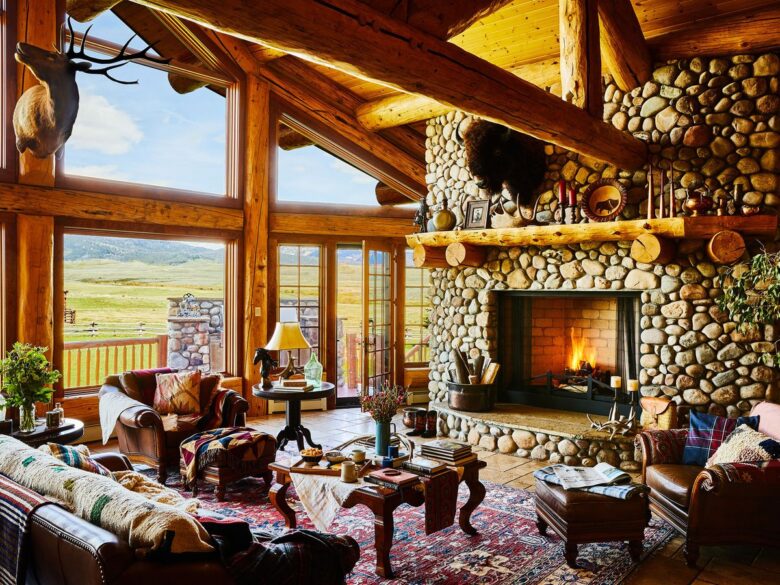
Source: elledecor.com
The floor forms the foundation of any room, and in a Western rustic home, it’s no different. Hardwood floors, with their rich grains and imperfections, are a natural choice. Reclaimed barn wood, with its history and character, can add a layer of authenticity. Stone tiles, with their cool touch and rugged texture, can be perfect for areas like kitchens or bathrooms. Area rugs, especially those made of natural fibers or cowhide, can break the monotony, introducing patterns and warmth. Remember, the goal is to create a harmonious blend of textures, ensuring the floor complements the overall decor.
9. Personal Touches
While the Western rustic style has its defining elements, it’s essential to infuse spaces with personal touches. Family heirlooms, custom-made decor, or even cherished photographs can make your rustic retreat uniquely yours. Whether it’s a quilt handed down through generations or a custom wood carving, these personal touches add layers of meaning, making your home truly special.
10. Outdoor Spaces
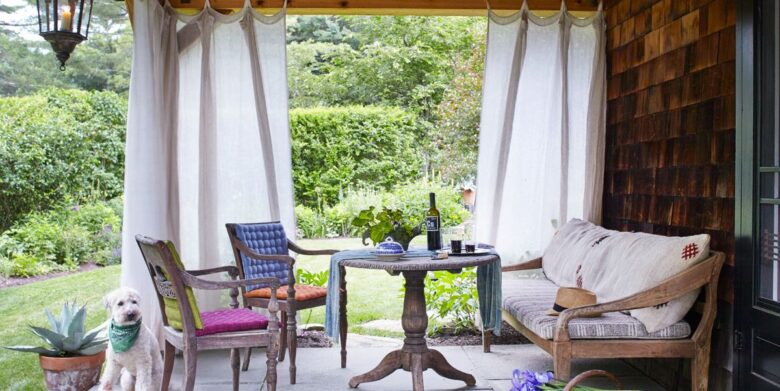
Source: housebeautiful.com
The rustic theme shouldn’t be confined to interiors. Extend this aesthetic to patios, porches, or even garden spaces. Wooden benches, wrought iron fixtures, or even a simple hammock can create cozy outdoor nooks. Consider adding a fire pit, perfect for those chilly evenings, or even a wooden swing, evoking memories of simpler times. Plants, especially those native to the Western landscapes, can further enhance the rustic feel, making outdoor spaces an extension of your cozy retreat.
Conclusion
Creating a Western rustic home is about more than just decor; it’s about evoking feelings of warmth, nostalgia, and a deep connection to nature. By blending natural materials, earthy colors, and vintage accessories, you can transform your living space into a cozy retreat, a sanctuary that tells a story. Whether you’re a seasoned decorator or just starting, let this guide inspire you to create a home that’s not just beautiful but also brimming with character and soul.
